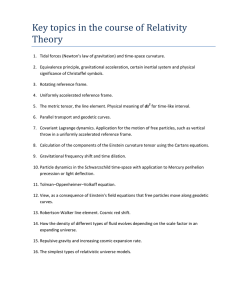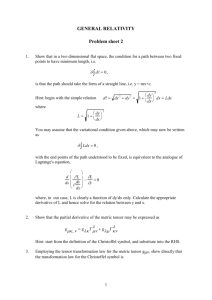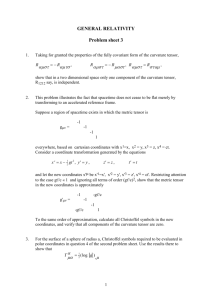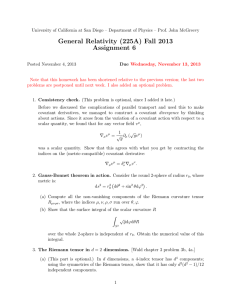Lecture 12 Curvature 12.1 Local inertial coordinates
advertisement
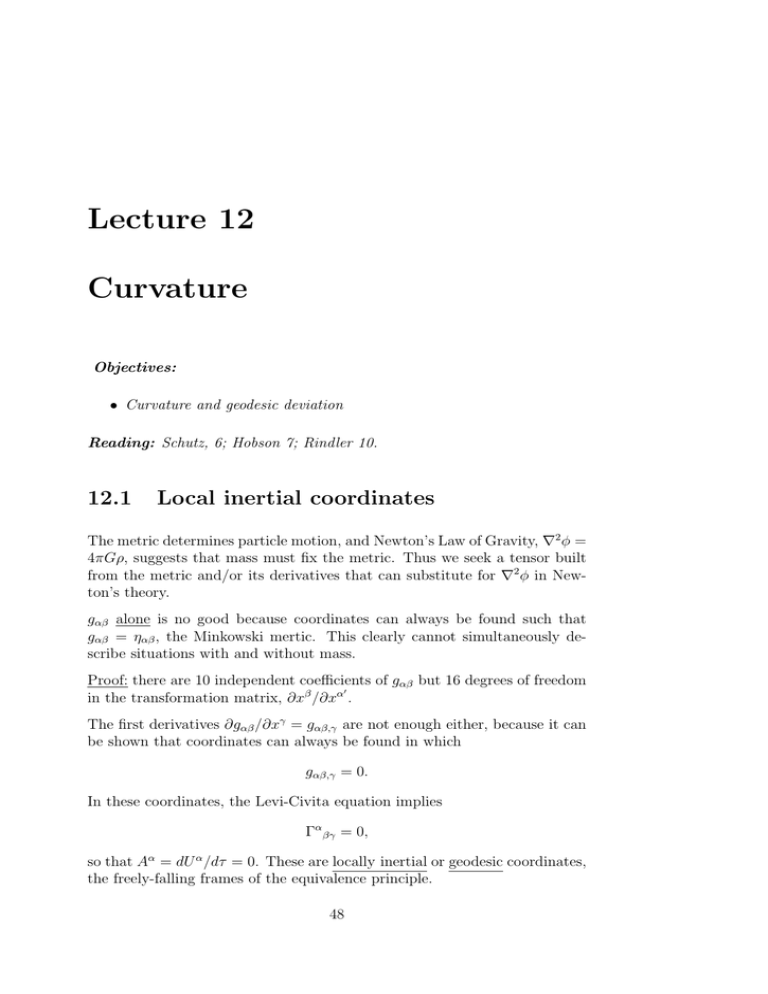
Lecture 12 Curvature Objectives: • Curvature and geodesic deviation Reading: Schutz, 6; Hobson 7; Rindler 10. 12.1 Local inertial coordinates The metric determines particle motion, and Newton’s Law of Gravity, ∇2 φ = 4πGρ, suggests that mass must fix the metric. Thus we seek a tensor built from the metric and/or its derivatives that can substitute for ∇2 φ in Newton’s theory. gαβ alone is no good because coordinates can always be found such that gαβ = ηαβ , the Minkowski mertic. This clearly cannot simultaneously describe situations with and without mass. Proof: there are 10 independent coefficients of gαβ but 16 degrees of freedom ′ in the transformation matrix, ∂xβ /∂xα . The first derivatives ∂gαβ /∂xγ = gαβ,γ are not enough either, because it can be shown that coordinates can always be found in which gαβ,γ = 0. In these coordinates, the Levi-Civita equation implies Γα βγ = 0, so that Aα = dU α /dτ = 0. These are locally inertial or geodesic coordinates, the freely-falling frames of the equivalence principle. 48 49 LECTURE 12. CURVATURE Corollary: in an inertial frame, covariant derivative → ordinary partial derivative =⇒ gαβ;γ = gαβ,γ = 0, gαβ;γ = 0 is tensorial, so the metric is covariantly constant, ∇g = 0. Conclusion: we need a tensor involving at least second derivatives of the metric, as suggested by ∇2 φ and g00 ≈ 1 + 2φ/c2 . 12.2 Curvature tensor Consider the expression ∇γ ∇β Vα = Vα;βγ , where Ṽ is an arbitrary one-form. This is a tensor (derivatives are covariant) which contains second derivatives of the metric. Expanding the covariant derivative with respect to γ: Vα;βγ = [Vα;β ];γ , = Vα;β,γ − Γσ αγ Vσ;β − Γσ βγ Vα;σ . Each of the three covariant derivatives, Vα;β etc, can be expanded similarly and one ends up with an expression of the form Vα;βγ = [. . .]Vµ,βγ + [. . .]Vρ,σ + [. . .]Vρ . The terms in brackets involve second derivatives of g. Unfortunately al- See handout 5 though the sum is a tensor, we cannot assert that the individual terms are tensors: we need just one term involving Vρ alone. If instead we consider the tensor Vα;βγ − Vα;γβ , the derivatives in V cancel and we find See handout 5 Vα;βγ − Vα;γβ = [∇γ , ∇β ] Vα = Rρ αβγ Vρ . where Rρ αβγ is the Riemann curvature tensor and is given by Rρ αβγ = Γρ αγ,β − Γρ αβ,γ + Γσ αγ Γρ σβ − Γσ αβ Γρ σγ . In flat spacetime, one can find a coordinate system in which the connection and its derivatives = 0, and so Rρ αβγ = 0. i.e. the Riemann tensor vanishes in flat spacetime. (i.e. covariant differentiation is commutative in flat space.) Do not try to memorise this!! LECTURE 12. CURVATURE 12.3 50 Understanding the curvature tensor Pictorially the relation Vα;βγ − Vα;γβ = Rρ αβγ Vρ , corresponds to the following: Figure: Vector parallel transported two ways around the same loop does not match up at the end if there is curvature Vector V~ is first parallel transported A → C → D, associated with V α ;βγ . Then the same vector is taken A → B → D, associated with V α ;γβ . Curvature causes the vectors at D to differ. Related to this, a vector parallel-transported around a loop in a curved space changes, e.g. Figure: Vector parallel transported on a sphere A to B to C to A has changed by the time it gets back to A. LECTURE 12. CURVATURE 12.4 51 Geodesic Deviation Figure: Two nearby geodesics deviate from each other because of curvature Consider the relative distance w ~ between two nearby particles at P and Q undergoing geodesic motion (free-fall). Can show that D2 wα + Rα γβδ ẋγ ẋδ wβ = 0, Dλ2 where ẋγ = dxγ /dλ etc. This is a tensor equation, the equation of geodesic deviation. Here the capital D’s indicate ’absolute’ or ’total’ derivatives, i.e. derivatives that allow for variations in components caused purely by curved coordinates, so that we expect D2 wα = 0, Dλ2 in the absence of gravity. The second term therefore represents the effect of gravity that is not removed by free-fall, i.e. it is the tidal acceleration. In Newtonian physics tides are caused by a variation in the gravitational field, ∇g, and since g = −∇φ, tides are related to ∇2 φ. This is another indication of the connection between curvature and the left-hand side of ∇2 φ = 4πGρ. This is the quantitative version of the notion from chapter 7 of two particles falling towards a gravitating mass moving on initially parallel-paths in spacetime which remain straight and yet ultimately meet.
